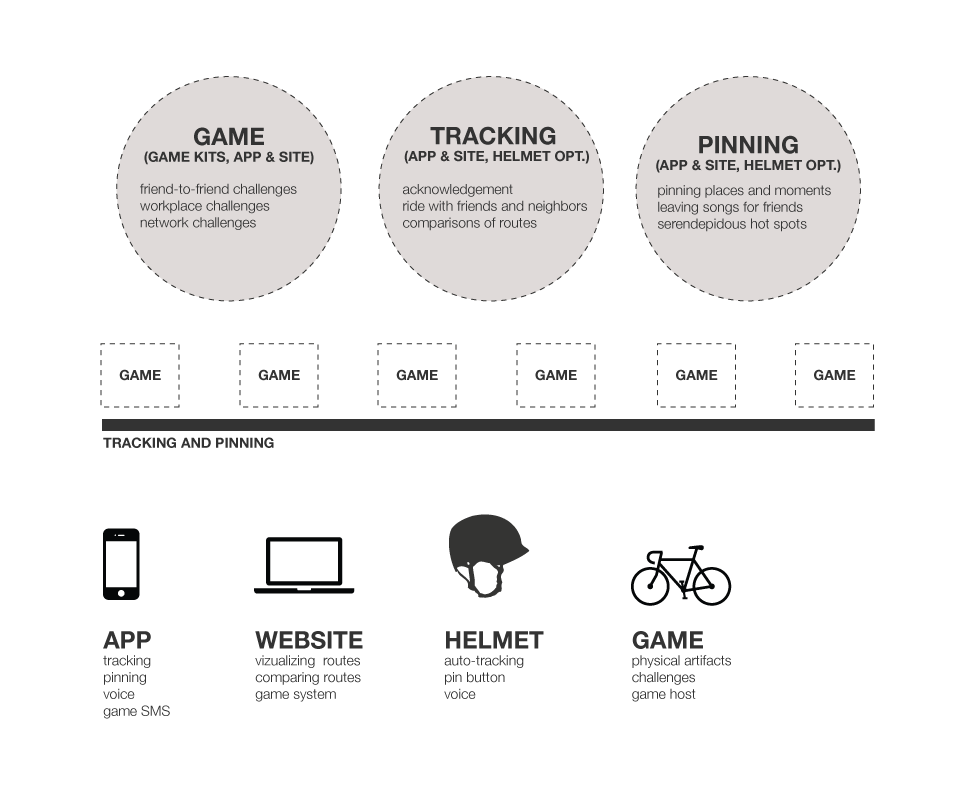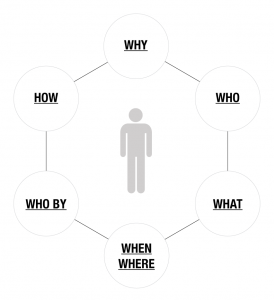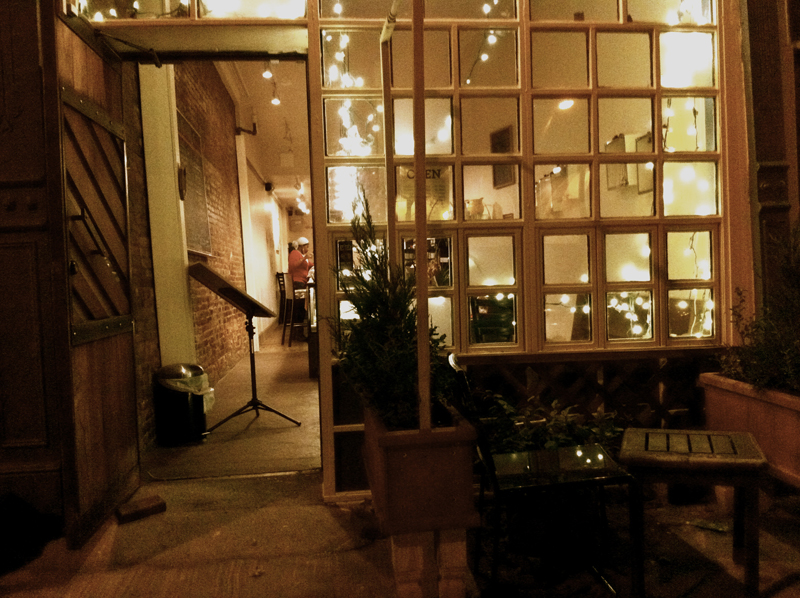This is a first shot at mapping our concept as it stands now. Gaming, tracking and pinning are the primary features. Tracking and pinning happen consistently, while games take place periodically. A mobile app, website, bike helmet and game system make up the service.
Monthly Archives: November 2011
Four Traits of a Game
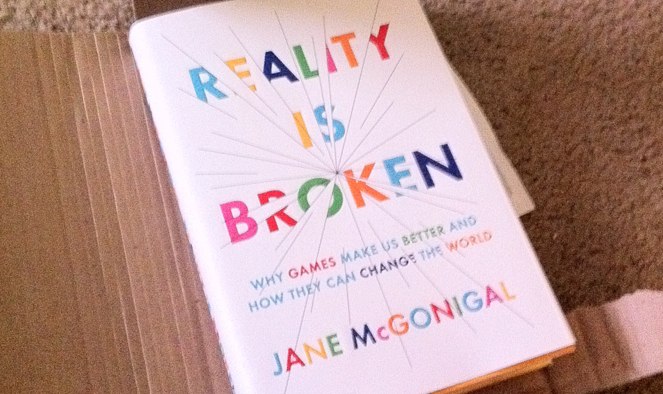
One way of motivating people to do things they didn’t really think they would do, is to make a game out of it. Gamification if you like. From Jane Mcgonigal’s book, I’ve found her defining traits of a game:
“The goal is the specific outcome that players will work to achieve.” It gives players purpose.
“Rules place limitations on how players can achieve the goal.” They push players to “explore preciously uncharted possibility spaces” and “unleash creativity and foster strategic thinking”.
“The feedback system tells players how close they are to achieving the goal.” This refers to points, a score, progress bar or levels. Real-time feedback pushes players.
“Voluntary participation requires that everyone who is laying the game knowingly and willingly accepts the goal, the rules, and the feedback.” It establishes common ground between players.
She says that everything else in games works to enhance these four primary traits. Wow.
Story Model, v.1
In my thesis workgroup, we are using a story model to help us delineate the intervention we are making with the thesis project. This is version one.
WHY: To create seamless and extra delightful bike rides
WHO: casual commuter, committed commuter, the ‘not yet convinced’
WHAT: framework/digital toolset for a better riding experience
WHEN/WHERE: during a ride, before and after a ride, ‘hunger moments’, planning periods
WHO BY: creators, bike nerd developers, bike community
HOW: mobile application paired with a physical helmet
Concepts worth thinking about:
- bike commuter bus, arranges friend meetups
- person becomes a ‘bookmark’ in the city
- auto-track behaviors
- compare miles with other interesting facts in person’s life
- use additional hardware forms to increase sensory feedback: vibrating wristbands, blinking light handlebar attachments
Mobilizing Superpowers
We took on a minor side project last week—to create a movie about our classmates’ internship experiences this summer:
As we are most definitely going to create more videos in the future to tell our thesis story, we thought this was a good opportunity to practice. We used the same formula as for our video for King of Two Wheels to try to make the process as smooth as possible. We learned: (1) we will never edit in iMovie ever again; (2) to create a video always takes longer than expected, even if you get better at it, seriously; and (3) do not take on side projects if you want to move forward with your main projects.
That last one is only halfway true, though. Showing our video to a room full of people at our department’s Open House on Saturday, led us into a few interesting conversations with people—conversations we made sure evolved around biking, of course! And as we were distracted by internship stories and video editing most of last week, the guilt forced us into having an epic thesis meeting for about 6 hours last night at a new cafe we found in our hood, Two Moon:
We spent a few hours doing some final edits to a blogging scholarship application essay, and gave it the title Human Superpowers and Talking Helmets. After the application was sent, our conversation went from mainly being about talking helmets, to evolving more and more around the superpower part; how to get people in touch with their human superpowers through biking. We talked, we role-played, we drank mulled cider, we drew on the back of napkins:
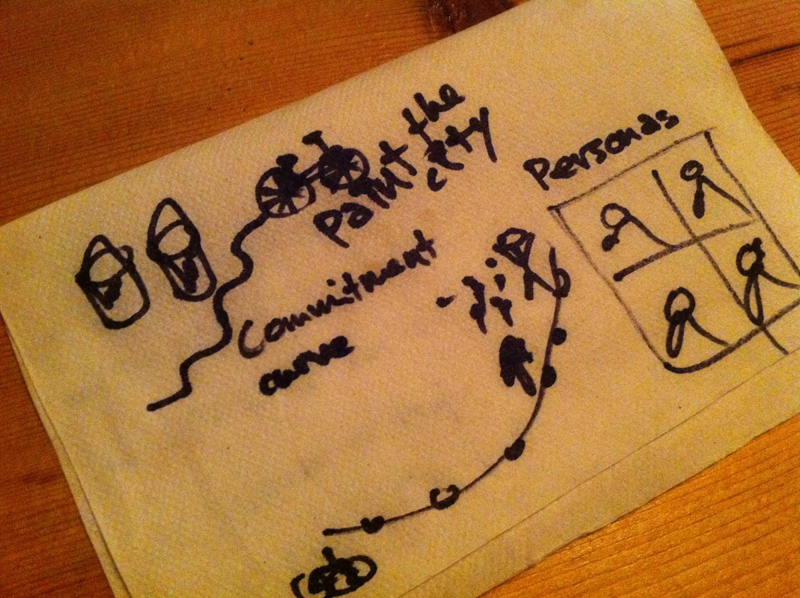 Napkin about the commitment curve, painting a city through biking, and personas. Yeah, we need to create some fake people!
Napkin about the commitment curve, painting a city through biking, and personas. Yeah, we need to create some fake people!
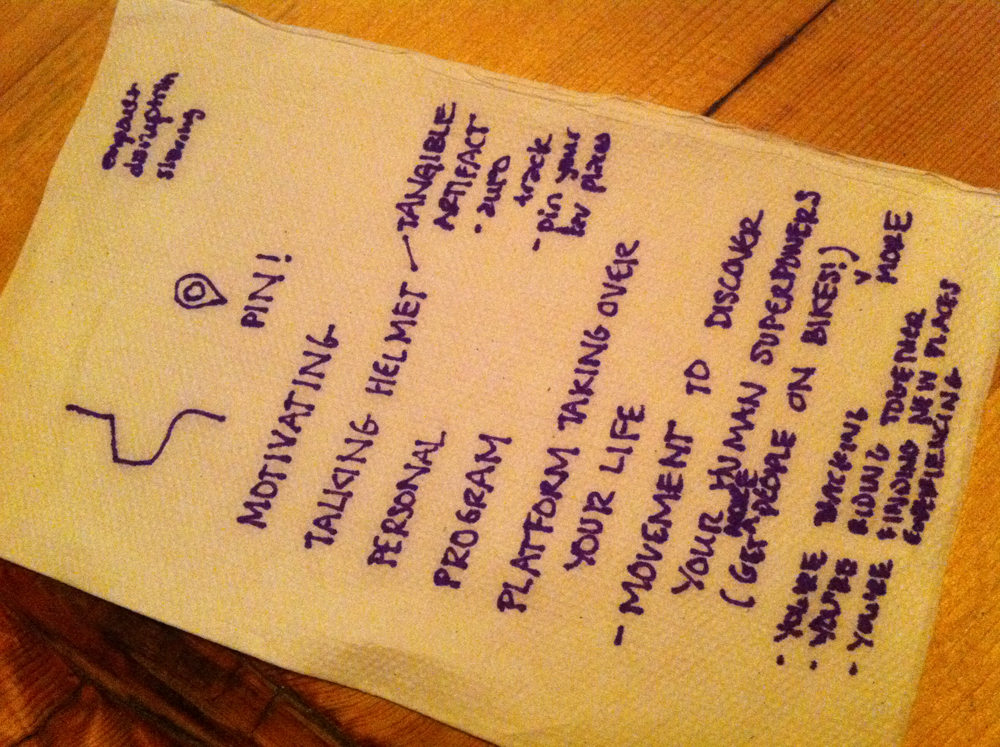 Napkin about building a platform for behavior change. Big words from little women. Yup.
Napkin about building a platform for behavior change. Big words from little women. Yup.
Nothing is formalized yet. We’re just publishing some napkin material to remember our conversations. But I think we felt last night that our thesis is going more in the direction of motivation and superpowers than toward the talking helmet. We are in no way giving up on the helmet. However, maybe it will play a smaller role than we initially thought.
Human Superpowers and Talking Helmets
This here essay is very meta—about why Carrie and I are blogging, our thesis, and the interaction design disciplin. It is part of our efforts to try to win this amazing blogging scholarship. We deserve it, right?!
Yes, I am a biker. This summer I realized that I should get comfortable with this title. Even though you will never catch me wearing neon spandex, I am perfectly apt to use my two wheels and human superpowers to get where I want, when I want. My bike allows me to be outdoors, and it helps me stitch together the huge and diverse city in which I live, New York. Biking makes me feel empowered and free, as well as a part of something bigger—an important movement toward a better quality of life and a healthy city environment.
As classmates at the School of Visual Arts’ Interaction Design program, Carrie and I both know the secret to how to get in touch with your superpowers. We bike together to and from our studio in Manhattan every day. On one of these rides we realized that it is time we spread the joy of biking. Our thesis year would be our opportunity.
PUBLISHING MESSY THOUGHTS
When you have seen the light, how do you make other people see it too? How do you help people change their behavior? We have had numerous questions and ideas. And though it’s hard to let people in on our messy thoughts, we do it through our collaborative blog. As thesis partners, Carrie and I realized early on that we had to overcome our perfectionist tendencies and dare to share our thoughts before they were completely thought through. Admittedly, our thoughts have been crazy, stupid, clever, naive, optimistic and everything in between. We need to document them all.
The blog format can be scary. As soon as you hit ‘publish’, your brain dump is there for the world to see. However, that trait pushes us to structure our thoughts in ways that are not only legible the moment we have an idea, but also comprehensible when we look back to ideas we had months ago. As our process so far has already shown us, the far-out concepts might very well be the ones to pursue!
A TALKING HELMET
We’re now deep in the process of figuring out how to create a smart and charming bike helmet to be used by bikers in urban environments. This helmet will likely become a talking helmet that knows what you’re up to, reflects upon it, and gives you directions, motivation, and tips about routes to ride and places to visit. To develop this idea we are researching aspects around wayfinding, motivation, tracking and discovery of a city from a bike seat. Our blog has become integral to keeping track of this research and moving forward in our pursuit of the core features that will make up the ultimate digital bike companion.
ENGAGING OUR COMMUNITIES IN BIKING
The blog enables us to talk to each other, as well as classmates, teachers and the bike community. Bike activists, local politicians, creatives and developers all have valuable insights that can shape the product we are making. However, considering the nature of our idea, we are also interested in those that are not yet convinced that biking is a viable form of transportation. For the moment, we hope that our enthusiasm for riding shines through the blog and may inspire others to ride. In the future, we hope that our talking helmet will help even more people make the leap from being a leisurely bike rider to a confident commuter.
AN OPEN DESIGN PROCESS
We do love biking, but we also love design! We hope that the openness around our thesis will give people insight in to our creative design process, and show how we, as interaction designers, develop a product that is both digital and physical. Design is not only about shapes, fonts and colors. Interaction design can involve strategy, concept development, marketing, user flows, interface design, prototyping, testing, electronics and software. The interaction design discipline is expansive, and we want to share our knowledge and techniques with the curious individuals eager to learn.
With our graduate program being three years young, it feels natural to create awareness around our practice. Our blog pushes us to find words to accompany our process, and in return helps us explain what we do to friends, family and aspiring interaction designers. If through the blog, we can motivate individuals to be mindful of, and even practice interaction design, it would mean a lot to us. We honestly believe that the “wicked problems” of the world, like world hunger, recession and global warming, could use some more design thinking. Even on smaller scale projects, the interaction design role is very rewarding. Yet, most people don’t even know what an interaction designer is!
A REWARDING COLLABORATION
We both had our “detours” before we found our career calling; Carrie’s background is in architecture, while mine is in information science. Given the multi-disciplinary nature of any interaction design project, our different backgrounds actually become our strengths. We could not take on our chosen thesis endeavor individually. We are dependent on each other’s skill-set, as well as each other’s energy, to move the process forward. Our blog is an important force in this. Even though the blog reveals process detours, half-baked ideas and up-hill battles with incomprehensible technology, we anticipate it telling a good story—a story about a rewarding collaboration, a year deep in thesis, and the journey of making a real, and hopefully working, product for urban bikers.
“Pin” a place
As we are interested in exploring the aspect of discovery in an urban environment, there are a few analogs out there. Foursquare, Yelp and Google Places are some typical examples. However the app Matchbook seems to be pretty straightforward in doing exactly what we want our bikers to do. Discover a place in the physical world, hit a button to “pin it” on a map, and get it added to your list of favorite places. I will download the app and test the functionality right now.
“Think of it as like Foursquare or Yelp, except without all the distractions and complications of check-ins, reviews, social networking and everything else those services offer. Matchbook is just about bookmarking your favorite places.”
-Vator (from the Matchbook web site)
Prototyping Features, Options
Note: We will probably need to purchase a smartphone for prototyping. I’m leaning much more toward the Android, not because I’m bias to my personal phone, but because as a platform it seems much more open for hacking than the iphone.
PHYSICAL BUTTONS AND SENSORS FOR RIDER FEEDBACK
One option is to use a dev board to interface between the phone and extra components (button, force sensor, etc). This gives us room to play with various sensors that may be embedded into the helmet. Sparkfun has products that would help us with this. For example, here’s a serial modem that allows you to interface an Arduino board with the Android or iPhone through the audio jack. This car audio project, also connecting with the phone through the audio jack, demonstrates the beauty of a physical button paired with a mobile phone.
Note: Wires are required for the first two examples. I think this is okay for early prototypes, but in the end, we do want to be wireless.
An alternative route is to hack the existing button on a bluetooth headset (or audio headphones) and reprogram it to do different commands. There are several examples of people doing this type of hack to boost the volume of audio, and perhaps there would be some direct correlations for what we would need to do. This gives us less control over selecting physical components, but may be more simple.
WHAT TO DO WHEN THE BUTTON WORKS
There are a couple simple things the button could to in the beginning to test the feasibility and experience of considered features:
1. To pin places; “Remember this location (longitude and latitude)”
2. To start/stop tracking
AND FINALLY FOR TRACKING AND GEO-LOCATION SOFTWARE
To be determined…We need something simple and with an open API.
STARTING POINTS FOR ANDROID APP DEVELOPMENT
A first look at building and android app
Android development tutorial
A bit about the android location API
Another android development 101
Feedback Questions
Questions for feedback from the participants of the King of Two Wheels:
QUESTIONS FOR CONTESTANTS
1. What about the game (which elements) made you bike more during the challenge?
2. What did you do, in regards to biking, during the game week that surprised you?
3. What did you enjoy about the game? What was delightful?
What did you not enjoy?
4. Which challenge did you enjoy the most?
5. Why did you do the challenges?
6. Which parts of the game got you excited vs. feeling like you just had to do them?
7. On a scale of 1 to 10, how aggressive were you in your efforts to win the game? Why or why not?
8. From your perspective, how aware of the game were your classmates?
9. What was confusing about the game?
etc.
QUESTIONS FOR PARTNERS
1. How did you respond to the invite? (excitement, confusion)
2. What was your perception of what the game was about?
3. What made or didn’t make you feel a part of the game?
4. How clear were the objectives of the game?
5. What did you feel like your role in the game was?
6. Why did or didn’t you place a bet?
etc.
